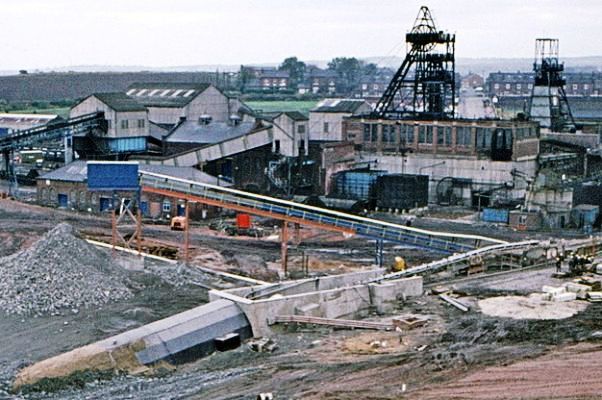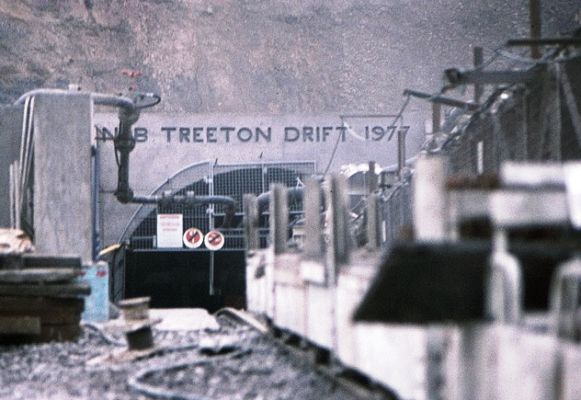 |
Northern Mine Research Society Registered Charity 326704 |
Treeton Colliery
 |
Copyright © Dr S Dumpleton and used with his kind permission |
The first sod was cut on October 13th 1875 and the sinking of two, four metre shafts got underway. By 1877, however, a trade depression left the company in the hands of its bankers. Nevertheless, sinking continued until the Barnsley seam was reached, at a depth of 302 metres, in February 1878. A little coal was produced, but then the mine stood idle until 1883 when full-time production began.
An underground link was made with the company's Fence Colliery and, from 1887 to 1902, the latter's output was brought to the surface at Treeton. Although exhausted, Fence was retained as a pumping pit for Treeton until 1957.
Treeton's take was crossed by the Spa and Upper Whiston faults, which ran from north-west to south-east and threw the beds down 110 and 73 metres respectively. The Kings Fault formed the north-eastern boundary with Silverwood Colliery's take.
The High Hazels seam, 87 metres above the Barnsley, was producing house coal by 1910, when 90 metre long faces were equipped with compressed air powered cutting machines. Shaking conveyors, taking coal off the face and loading it into tubs, were added in 1914.
A third producing colliery was added to Rothervale Collieries portfolio when Thurcroft Main was sunk between 1909 and 1912. In March 1918, however, Rothervale Collieries became part of the United Steel Companies Ltd, which had other collieries and haematite mines in Cumberland.
The 1.3 metre thick Wathwood seam, 56 metres above the High Hazel, was worked between 1919 and 1931.
New screens and a tippler house were built in 1930. The pit-top railway system was also relaid, and a new electric winder, engine house and headgear were put on the upcast shaft. Both shafts were deepened to the Swallow Wood seam, at 369 metres, between 1936 and 1937, with a new pit bank and headgear on the downcast shaft. An electric winder was added to the latter shaft in 1943, and the boiler house and chimneys were demolished.
The Swallow Wood seam, which had 1.1 metre of good house-coal separated by a 0.225 metre dirt band, was worked from the early 1940s until 1951. It was then incorrectly called the Haigh Moor seam, which is stratigraphically lower. This, however, may have either been a genuine mis-correlation of the two seams, or a shrewd marketing ploy because the true Haigh Moor was a coal of excellent quality.
 |
Copyright © Dr S Dumpleton and used with his kind permission |
To increase capacity, under the Plan for Coal, a deeper area of Swallow Wood seam was entered by driving a 3,000 metre long drift. A shallow tunnel was also driven from a staple pit at the mine, under the ridge on which the village of Treeton sits, to surface between the railway and the river Rother. Treeton coal was transported on a conveyor belt, through the tunnel, to the Orgreave coke works.
In the later 1980s, however, prospection by seismology and boreholes showed that the potential of the remaining area of the Swallow Wood seam was seriously degraded by faulting. The only future for the mine involved working a single face with a smaller workforce. Indeed, the returns for 1989 and 90 suggest that the workforce underground fell by 35% and that on the surface by 45%
It was not enough, however, and the British Coal Corporation closed Treeton in December 1990. Some men worked on into 1991 building water dams underground to help prevent water flowing down dip and troubling mines to the east. The site was cleared in 1992.
Further reading:
- NMRS Records, Gazetteer of British Collieries
- Sections of Strata of the Yorkshire Coalfield, Midland Institute of Mining Engineers, 1927
- Hill, A. The South Yorkshire Coalfield: A History and Development (Stroud: Tempus, 2002)
- Hill, A. Colliery Ventilation (Matlock: Peak District Mines Historical Society Ltd, 2000)
- Hill, A. Coal: A Chronology for Britain (NMRS, British Mining No.94, 2012)